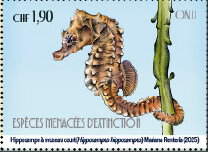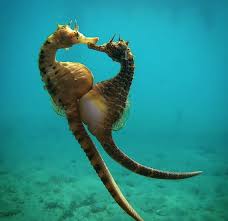Stamp: Short-Snouted Seahorse (Hippocampus hippocampus) (UNO Geneva 2025)
Short-Snouted Seahorse (Hippocampus hippocampus) (UNO Geneva 2025)
02 May (UNO Geneva ) within release Endangered Species (2025) goes into circulation Stamp Short-Snouted Seahorse (Hippocampus hippocampus) face value 1.90 Swiss franc
| Stamp Short-Snouted Seahorse (Hippocampus hippocampus) in catalogues | |
|---|---|
| Colnect codes: | Col: NT-GE 2025.05.02-01d |
Stamp is horizontal format.
stamp from se-tenant block of fourAlso in the issue Endangered Species (2025):
- Stamp - Bulnesia sarmientoi (Gonopterodendron sarmientoi) face value 1.90;
- Se-tenant - Endangered Species face value 4*1.90;
- Full Pane - Endangered Species face value 16*1.90;
- Stamp - Jatamansi (Nardostachys jatamansi) face value 1.90;
- Stamp - Short-Snouted Seahorse (Hippocampus hippocampus) face value 1.90;
- Stamp - White-headed duck (Oxyura leucocephala) face value 1.90;
Stamp Short-Snouted Seahorse (Hippocampus hippocampus) it reflects the thematic directions:
Animals are multicellular, eukaryotic organisms of the kingdom Animalia (also called Metazoa). All animals are motile, meaning they can move spontaneously and independently, at some point in their lives. Their body plan eventually becomes fixed as they develop, although some undergo a process of metamorphosis later on in their lives. All animals are heterotrophs: they must ingest other organisms or their products for sustenance.
Marine life, or sea life or ocean life, refers to the plants, animals and other organisms that live in the salt water of the sea or ocean, or the brackish water of coastal estuaries. At a fundamental level, marine life helps determine the very nature of our planet. Marine organisms produce much of the oxygen we breathe. Shorelines are in part shaped and protected by marine life, and some marine organisms even help create new land. Altogether there are 230,000 documented marine species, including over 16,000 species of fish, and it has been estimated that nearly two million marine species are yet to be documented. Marine species range in size from the microscopic, including plankton and phytoplankton which can be as small as 0.02 micrometres, to huge cetaceans (whales, dolphins and porpoises) which in the case of the blue whale reach up to 33 metres (109 feet) in length, being the largest known animal.
A seahorse (also written sea-horse and sea horse) is any of 46 species of small marine bony fish in the genus Hippocampus. "Hippocampus" comes from the Ancient Greek hippókampos (ἱππόκαμπος), itself from híppos (ἵππος) meaning "horse" and kámpos (κάμπος) meaning "sea monster" or "sea animal".Having a head and neck suggestive of a horse, seahorses also feature segmented bony armour, an upright posture and a curled prehensile tail. Along with the pipefishes and seadragons (Phycodurus and Phyllopteryx) they form the family Syngnathidae.



